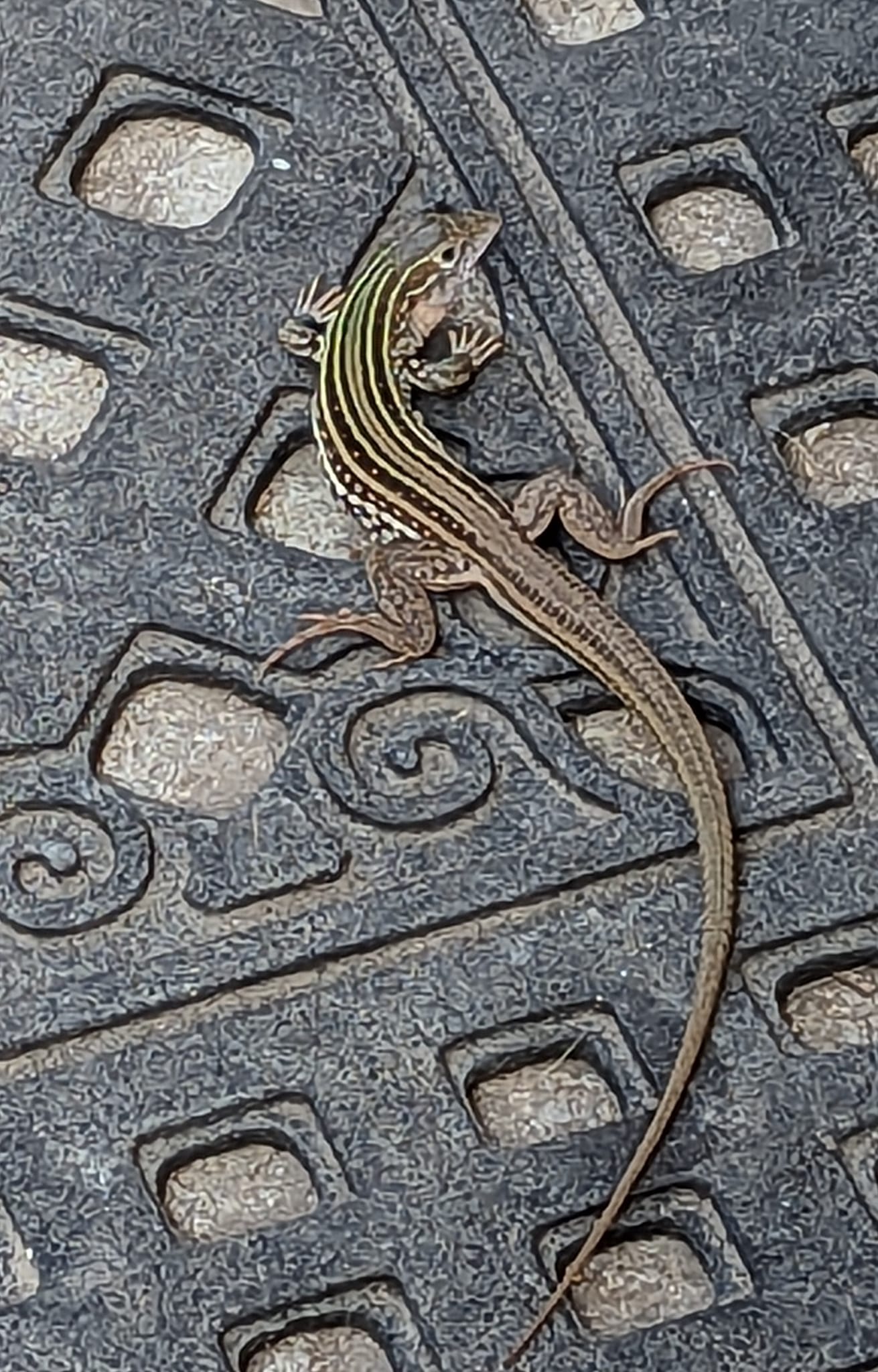by M. Kathy Raines
The long-tailed, striped lizard, its limbs splayed out like a gecko’s, suddenly materialized on the porch as I swiveled back from watering the birds.

Snapping photos, I crept towards its tail end as the whiptail weighed its options: whether to bolt under an inch-wide crevice between porch and brick or keep still, undetectable and undevoured. Within seconds, it repositioned itself, then vanished. Unlike its neighbors, our resident brown and green anoles, this active forager sprints in stop-and-start bursts; it doesn’t pose for pictures.
We inhabit lizard paradise, even in residential neighborhoods. Why, I’ve seen five species in my Brownsville backyard this summer— Texas spotted whiptails, brown and green anoles, Mediterranean geckos and Texas spiny lizards.
The Texas spotted whiptail, also called common spotted whiptail (Aspidoscelis gularis) thrives in deserts, grasslands and our own semi-arid thornscrub throughout most of Texas, minus the eastern half and some of the trans-Pecos and the Panhandle, as well as parts of Oklahoma, New Mexico and Mexico. Spanish-speakers call it huico pinto del noreste (painted whiptail of the northeast) or huico texano.

Seven or eight dorsal stripes, usually greenish, line this whiptail, with pale spots dotting the dark portions between them. Its colors allow for camouflage, long legs grant it speed, and an air-resistant, streamlined body, agility. The throat of the larger, mature male is pink or orange-tinted, and its venter, or underside, is bluish or blue-black. A female’s belly and throat are plain, while a juvenile, whose stripes are more distinct, lacks spots in the dark portions and wears a reddish tail.
This whiptail reaches from about 6 ½ to 11 inches, including its conveniently long, usually reddish-colored tail, one which contains stores of fat and provides the balance required for quick maneuvers. During combat, its tail, like those of many lizards, may snap off, leaving a frustrated predator clutching that mere remnant in its claws or beak. Still, its tail is precious; it regenerates, but the spare is shorter, stiffer and more brittle, increasing its vulnerability.
Especially in the summer at Sabal Palm Wildlife Sanctuary, I see scores of Texas spotted whiptails crisscrossing in dashed diagonals, constantly hunting, but also evading their many predators, including snakes, roadrunners, and hawks—especially the gray, with its penchant for lizards. They’re also snacks for great-tailed grackles, great kiskadees and several aquatic birds.
Probing with its snout and sometimes forelimbs, this whiptail, aided by its flickering, scent-detecting tongue, scours grass, dirt and leaf litter for grasshoppers, termites, beetles, spiders and larvae, its prey providing most of its hydration. It also eats some leaves and blossoms, including dandelions.
Whiptails hunt on summer afternoons when temperatures reach the low 100s, but when it’s especially hot, may rest in the shade, under rocks or in underground burrows. They also perch with appendages lifted, minimizing heat, and pant, cooling themselves with evaporation. Being cold-blooded, they, like other reptiles, warm themselves in the morning sun. In the winter, whiptails may undergo brumation, or a period of lethargy somewhat akin to hibernation.

These whiptails court, engaging in head bobbing, and also release chemical pheromones. Mating in late spring, the male loops around the female, arching over her hips and seizing her abdomen with his mouth. As I approached the porch with my mower this spring, I witnessed two whiptails, locked in a copulatory embrace, running erratically until, tangled together, they organized themselves into a mutual slide between the concrete and house.
In July, the female lays her sole clutch of from 1-8 eggs in a chamber in her underground burrow. Like most reptiles, she pays them no heed. Then in late summer, 1-1 ½ inch hatchlings emerge, maturing quickly and reaching sexual maturity that season.
Through hybridization, this whiptail has contributed to two all-female Texas species—the Chihuahuan spotted whiptail and Laredo striped whiptail. Though they are parthenogenetic (meaning “virgin birth), or reproduce asexually, females engage in pseudocopulation. After laying eggs, females, with resultant high levels of progesterone, begin behaving like males—courting females and mock-mating—an activity which abets estrogen production in the other, thus, increasing her fertility.

Though the Texas spotted whiptail is sufficiently abundant that one may collect and sell it, most reptile aficionados forego the opportunity, put off by its difficulty to catch and its tendency to dash around, sometimes ramming into glass or biting its host. Nevertheless, determined fans have taught them to eat mealworms from their palms.

